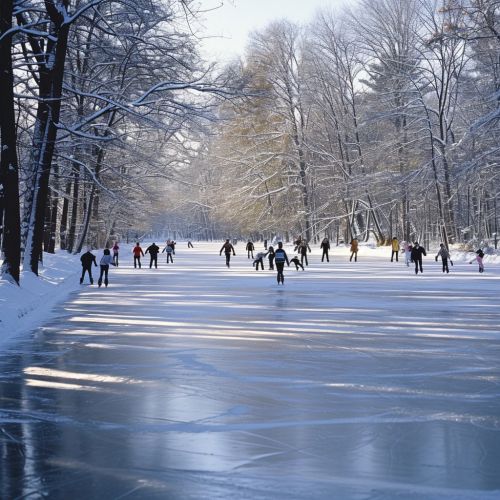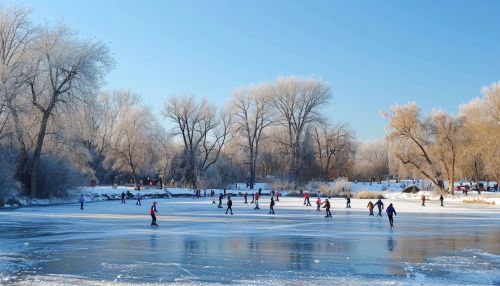Ice Skating
History
Ice skating has a long and storied history, dating back to prehistoric times. The earliest known ice skates were made from animal bones and were used by early humans to traverse frozen bodies of water. These primitive skates were attached to the feet with leather straps and were propelled forward using poles. The Iron Age saw the development of metal-bladed skates, which allowed for more efficient and controlled movement on ice.
The practice of ice skating began to evolve into a recreational activity in the 17th century, particularly in the Netherlands and England. The first known skating club, the Edinburgh Skating Club, was formed in Scotland in 1642. Ice skating became a popular winter pastime among the European elite, and by the 19th century, it had spread to North America.
The first artificial ice rinks were constructed in the mid-19th century, allowing for year-round skating. This development, coupled with the invention of the tube skate (a skate with a hollow blade), helped to popularize ice skating as a sport. The first World Championship in figure skating, a discipline of ice skating, was held in 1896.


Types of Ice Skating
There are several different types of ice skating, each with its own set of rules, techniques, and equipment.
Figure Skating
Figure skating is perhaps the most well-known type of ice skating. It is a sport in which individuals, duos, or groups perform spins, jumps, and other moves on ice. Figure skating is characterized by its emphasis on grace and precision, and it is often set to music.
Speed Skating
Speed skating involves racing on ice. Competitors skate around an oval track, with the goal of completing the course in the fastest time. Speed skating requires strength, endurance, and excellent technique.
Ice Hockey
Ice hockey is a team sport played on ice. Players use sticks to shoot a puck into the opposing team's goal. Ice hockey is a fast-paced, physical sport that requires skill, strategy, and teamwork.
Synchronized Skating
Synchronized skating is a discipline of figure skating where 8–20 skaters perform a program together. It uses the same judging system as singles, pairs and dance and is characterized by teamwork, speed, intricate formations and challenging step sequences.
Equipment
The primary piece of equipment used in ice skating is the ice skate. Ice skates consist of a boot attached to a blade. The design and construction of the skate can vary greatly depending on the type of ice skating being performed.
Figure Skates
Figure skates have a set of large, jagged teeth called toe picks on the front of the blade. These are used for executing jumps and other maneuvers. The blade itself is typically longer than the boot and is slightly curved, aiding in balance and control.
Hockey Skates
Hockey skates are designed for speed and maneuverability. They have a shorter, curved blade and lack the toe picks found on figure skates. The boot of a hockey skate is typically more robust and offers more protection than a figure skate.
Speed Skates
Speed skates are designed for maximum speed. They have a long, straight blade and a low-cut boot that allows for greater ankle flexion.
Techniques
Ice skating involves a variety of techniques, many of which are specific to the type of skating being performed. However, some basic techniques are common to all forms of ice skating.
Striding and Gliding
The basic movement in ice skating is the stride and glide. Skaters push off with one foot (the stride) and glide on the other (the glide foot). The glide foot should be kept straight and the body weight should be over the skate.
Stopping
There are several ways to stop while ice skating. The most common method is the snowplow stop, where the skater pushes the insides of the skates outward, creating friction with the ice and slowing down.
Turning and Crossovers
Turning on ice skates involves shifting weight to the inside edge of the skate. Crossovers, where one foot crosses over the other, are used to maintain speed during turns.
Jumps and Spins
In figure skating, jumps and spins are fundamental elements. Jumps involve the skater leaping into the air and spinning, then landing smoothly on the ice. Spins involve the skater rotating rapidly on the spot.
Ice Skating in Popular Culture
Ice skating has been featured in numerous films, television shows, and books. It is often portrayed as a glamorous and exciting activity. Some popular films that feature ice skating include "The Cutting Edge," "Ice Princess," and "Blades of Glory."
Ice skating is also a major part of the Winter Olympics. Figure skating, speed skating, and ice hockey are all Olympic sports, and they draw large audiences both at the games and on television.
